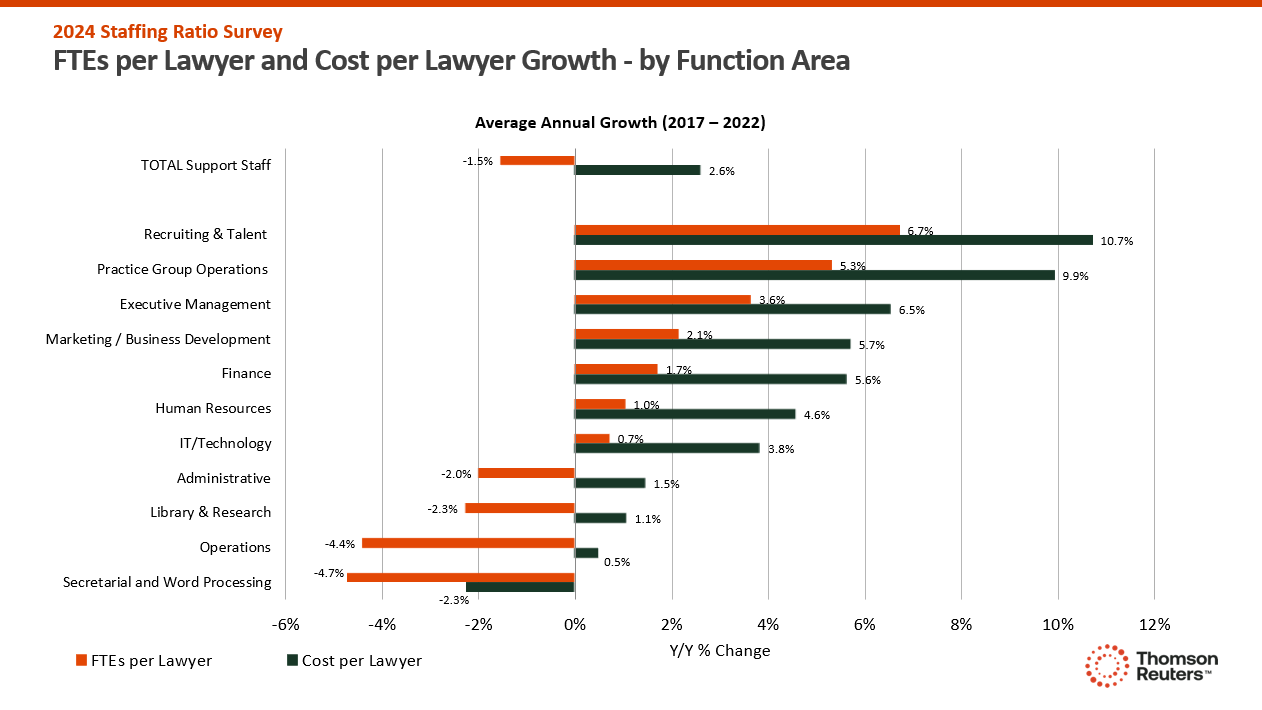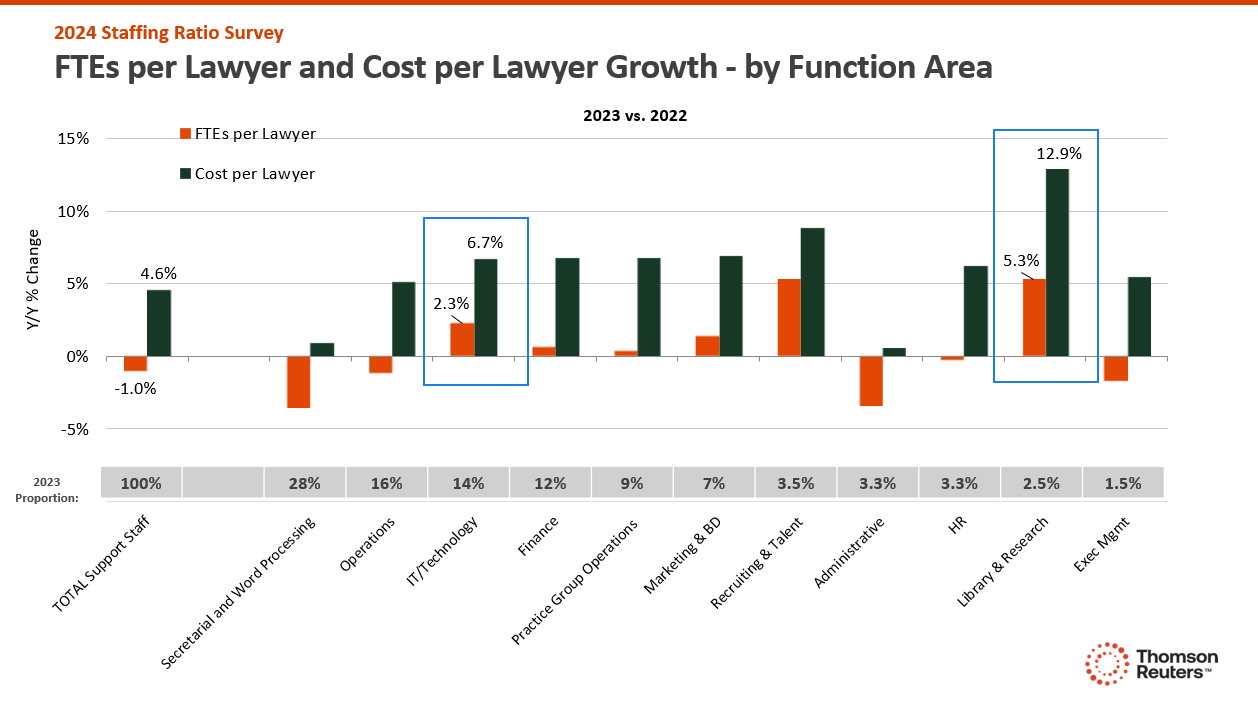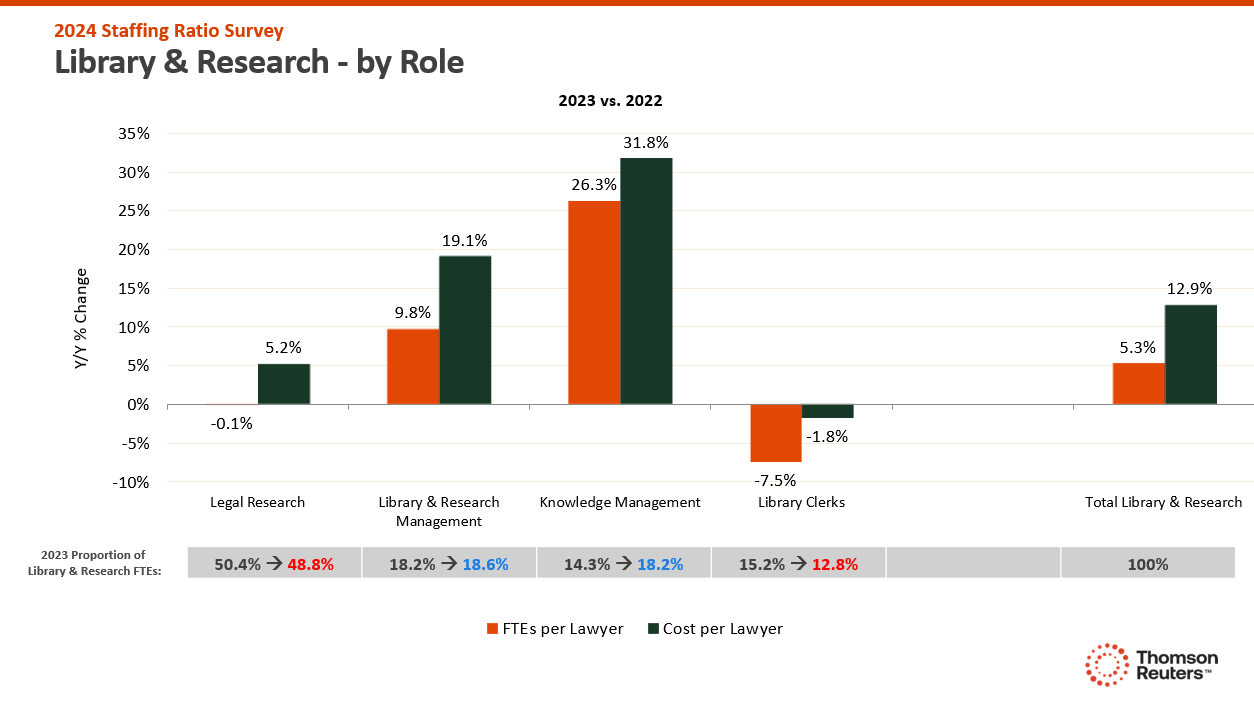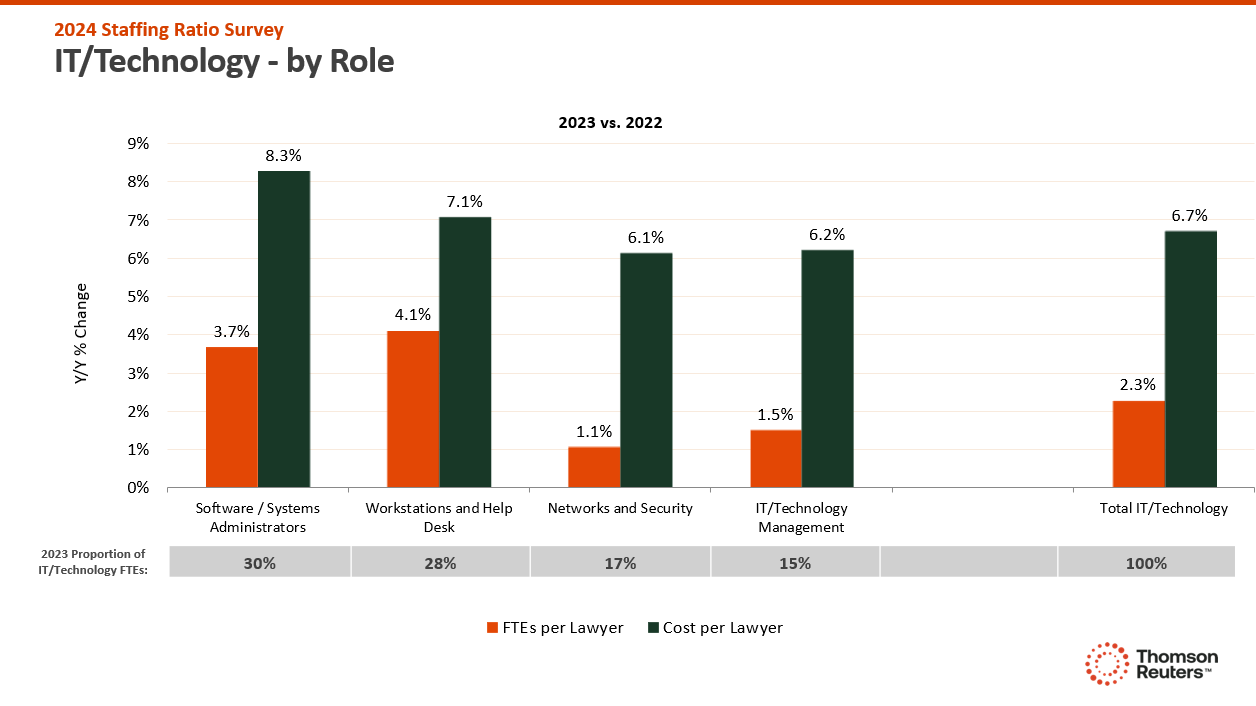New data shows that law firms are shifting priorities towards more specialized and expensive support staff roles, with notable increases in library & research and IT & technology functions
In the most recent year, the landscape of support staff within law firms has shifted in an intriguing way. Traditionally, there have been several very consistent trends in support staff at law firms, including a consistent decline in the ratio of total support staff to lawyers. Law firms, on average, had 81 support staff full-time equivalents (FTEs) for every 1 lawyer in 2023, compared to 95 support staff FTEs for every 1 lawyer in 2017.
Indeed, from 2017 to 2022, the ratio of support staff to lawyers of several support staff function areas — broader groups of individual support staff roles — were in decline, including:
-
-
- secretarial & word processing roles, which declined by 4.7% per year on average;
- operations roles, which declined by 4.4% per year on average; and
- library & research roles, which declined by 2.3% per year on average.
-
In parallel with the overall trend in support staff’s ratio-to-lawyers declining year after year, another significant trend has been an overall increase in the compensation for support staff on a per-lawyer basis, commonly called cost per lawyer. This metric measures the total compensation of a function area and divides that by the number of lawyers at a firm, showing the cost of that specific function area, per lawyer.
Data from Thomson Reuters most recent Staffing Ratio Survey shows that support staff costs per lawyer have increased very consistently at the same time that the ratio of support-staff-to-lawyers has declined. This likely demonstrates that law firms are increasingly turning to more specialized and more expensive support staff professionals, while requiring a relatively smaller number of those professionals per lawyer. Over the last seven years there have been consistently sharp reductions in lower-cost support staff FTEs (particularly in the largest support staff function areas like secretarial & word processing and operations staff), simultaneously with extensive cost increases in smaller, more specialized staff function areas.

Are we witnessing a pivot in strategy?
Since 2017, library & research roles have largely followed the overall trend seen among total support staff, as one of the four major function areas experiencing declines in the ratio of staff-to-lawyer headcount. Library & research roles have also experienced the third-slowest cost-per-lawyer growth rates over this period, suggesting that these roles have potentially been less specialized and expensive relative to other support staff roles like finance professionals or practice group operations professionals.

However, in 2023 we saw a reversal of this trend with library & research roles growing by 5.3% in terms of FTEs-per-lawyer and growing 12.9% in terms of cost-per-lawyer. This function area led all others in both of these metric categories, although library & research tied with recruiting & talent in FTEs-per-lawyer growth. Even so, this is a very unusual development that requires a closer look into the key driving forces.
There were significant shifts seen in terms of what roles make up the overall library & research function area, and significant changes in firms’ desires for those professionals. Before going into that, it should be noted that the library & research function area primarily consist of the following roles: legal research, library & research management, knowledge management, and library clerks.
Legal researchers as well as library clerks saw their FTEs-per-lawyer ratio decline in 2023, and also saw significant reductions as a proportion of total library & research FTEs. On the other hand, knowledge management and library & research management saw rapid increases in their ranks. Knowledge management in particular experienced a 26.3% increase in their FTEs-per-lawyer, and a 31.8% increase in their cost-per-lawyer.
As a result of this increase and the aforementioned declines in legal research and library clerks, knowledge management increased its proportion of total library & research FTEs by roughly 4 percentage points. These roles now make up 18.2% of total library & research FTEs, compared to making up 14.3% in the previous year.

Overall, no other function area saw a greater shift in role proportions than library & research, meaning that, in some way, this function area clearly has undergone the greatest shake up over the last year compared to any other function area.
It should be noted however, that library & research overall only makes up 2.5% of total support staff and the average firm only employs 10 FTEs in this support staff function. For this reason, year-to-year changes can be magnified if there are any substantial changes in headcount or compensation. Additionally, as this function area has traditionally been one in decline, achieving a positive growth rate is easier given a more favorable baseline. For these reasons, we are not expecting to see this elevated level of FTE-per-lawyer or cost-per-lawyer growth every year going forward.
For more on the Thomson Reuters Staffing Ratio Survey, listen to the latest Thomson Reuters Institute Insights podcast on Spotify
That being said, the changes in direction and the magnitude of cost increases within knowledge management and library & research management roles are significant. These changes in 2023 echo the broader support staff trend that has law firms investing in roles that are highly specialized and not easily automatable. Instead, we believe that firms will continue to focus on hiring specialized roles that can utilize advanced knowledge management and research management systems.
What may be happening is that the growth in knowledge management and library & research management roles is in preparation for increased use of generative artificial intelligence (GenAI) tools. As firms get their data in order, they start to gather and clean the training data that they will soon be using with AI workflows. The elevated cost-per-lawyer growth that comes from these advancements is already evident as firms’ research tools require a more sophisticated set of skills to fully be utilized.
Firms increasingly focused on data security
In line with the acceleration in firms’ investment in more specialized and expensive FTEs, IT & technology was the third-fastest growing area in FTEs-per-lawyer at 2.3%, and the sixth-fastest growing area in terms of cost-per-lawyer at 6.7%.
This function area makes up a much larger proportion of total support staff (14%) compared to a smaller function area like library & research, so the movement within IT & tech affects the overall makeup of support staff to a greater degree. Additionally, growth in this area could be considered to be more indicative of where firm priorities lie given that year-over-year growth is expected to be less impacted by outlier firms or favorable baselines from the previous year.
What we saw in 2023 within IT & tech staff once again tells us that firms are investing in higher-paid professionals with more advanced skills. The growth in cost-per-lawyer and FTEs-per-lawyer for four of the main roles under IT & tech shows a substantial gap between the two growth rates. Indeed, the gap between these two growth rates essentially measures per-role compensation increases, or the cost pressures that firms face when they hire an FTE in each of these roles.

Networks & security professionals in particular saw a rapid increase in their pay, with the greatest gap between their cost-per-lawyer and FTEs-per-lawyer growth. This trend in compensation growth is expected to continue as firms increasingly adopt cloud-based infrastructure and incorporate GenAI into their work. Security, for instance, is quickly becoming one of the top operational priorities for many law firms, and it is very likely that this will result in these roles being increasingly well paid.







